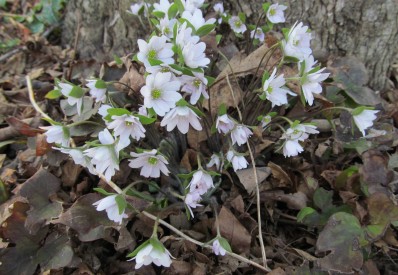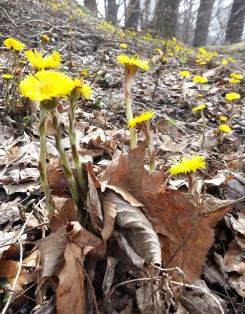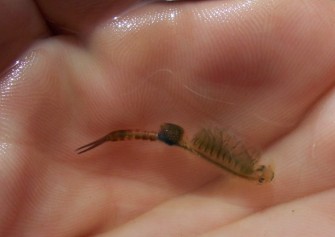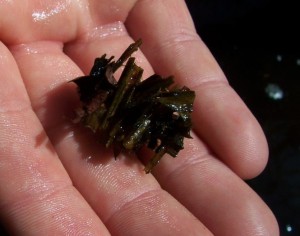I have to apologize (again) for not posting the past few weeks – family priorities took precedence.


Cinnamon fern fiddlehead. American robin nest.
Spring progressed at a rapid clip since my last post three weeks ago, driven by above-average temperatures and southerly winds carrying northbound migrants. While the recent cold snap is slowing the progression, it will cause just a brief setback. In fact, a glance back through nature records from the past 30 years indicates that plant growth and animal activities are just a little behind schedule so far this spring. Early blooming trees and wildflowers are blooming about a week later than average. Steadily warming temperatures through the coming week will bring them out of their current state of suspended animation. Spring migrant songbirds are reaching the Buffalo-Niagara Region generally about a week later than normal. The forecast for the coming week indicates that the dominant wind direction will be out of the north; therefore, we likely will not see a major influx of northbound migrant birds in our region this week.
Below are highlights of what you can expect to find outdoors in the Buffalo-Niagara Region during the coming week. Check out the list of nearly 300 publicly accessible sites (“B-N Region & Sites” tab on this web page) to find sites to explore in your neighborhood and throughout the Buffalo-Niagara Region.
Lake, Pond, Stream & Wetland Conditions:
- Lake Erie ice cover finally diminished enough for the ice boom to be removed starting on April 20. The Lake Erie water temperature off Buffalo warmed to 36°F as of April 21.
- The Lake Ontario water temperature off Greece (Monroe County) warmed to 39°F as of April 21.
- Inland ponds and wetlands are exhibiting annual high water levels.
- Moderate to heavy rainfall over the past week will keep water levels relatively high in many streams.
Ferns and Grasses/Sedges/Rushes:
- Fiddleheads (furled leaf fronds coiled like the scroll of a violin head) have emerged for a few species of wetland ferns (e.g., cinnamon, royal, and sensitive ferns).
- While we’ve seen just slight grass growth in our lawns, wool-grass (a type of bulrush) and a variety of sedge species have grown several inches in wet meadow and other wetland habitats.
Wildflowers:
- Skunk cabbage is nearly done flowering. Its large skunky-smelling leaves are now evident in forested wetlands.
- The large leaves of false hellebore are also evident in forested wetlands, but this species won’t flower until late May or June.
- Coltsfoot has been blooming across most of the region for the past couple weeks and will continue during the coming week. Look for its yellow, dandelion-like flowers.
- The earliest of the spring ephemeral wildflowers, sharp-lobed hepatica and bloodroot, have been blooming in upland forest habitats across much of the region for the past week. They will continue blooming during the coming week.
- Additional spring ephemeral wildflowers (e.g., spring cress, purple cress, spring beauty, blue violet, red trillium, blue cohosh, cut-leaved toothwort) have started blooming in some areas, but peak blooming for this assemblage of woodland wildflowers is a week to 10 days away.
- Lesser celandine, an invasive non-native species of buttercup, will also continue to bloom this week. It is most common in floodplain forest habitats.
- The leaves of wild leek and yellow trout lily adorn the forest floor of many of our woodlands. The former smells like onion and the latter is mottled, resembling a brook trout.

 Sharp-lobed hepatica in full bloom. Large patch of coltsfoot in bloom.
Sharp-lobed hepatica in full bloom. Large patch of coltsfoot in bloom.
Trees and Shrubs:
- The flowering of red and silver maple trees is now slightly beyond peak, but still adding subtle color to our leafless woodlands.
- Pussy willow flowers are pastel yellow and green as they produce an abundance of pollen.
- Spicebush has started to flower in forested wetlands – look for its small yellow blossoms. Blooming will approach peak over the next week.
- A few serviceberry trees and shadbush shrubs have broken bud in forest understory and edge habitats. Blooming will approach peak over the next week.
- Eastern cottonwood has started to flower. Its cotton-like fluff and seeds will be fill the air in early June.
- Leaves of Tartarian honeysuckle, an invasive non-native shrub that has infested many woodland habitats in our region, are already growing. It typically leafs-out two weeks or more ahead of most of our native shrub species. One exception is choke cherry, which o keep pace with Tartarian honeysuckle.
Insects & Other Terrestrial Invertebrates:
- A surprising diversity and abundance of invertebrates are now flourishing in vernal pool and wetland habitats: fingernail clams, amphipods, isopods, fairy shrimp, caddis fly larvae, dragonfly nymphs, giant water bugs, an assortment of aquatic beetles, water striders, etc.
- Ticks are now active so wear protective clothing and repellent, and do tick-checks after every outing.
- Glow-worms (firefly larvae) can now be found on the surface of the ground after dark, occasionally flashing their bioluminescent abdomens.
- Common green darners have migrated back into our region over the past couple weeks.
- Watch for mourning cloak, eastern comma, and question mark butterflies (all of which overwinter as adults) during warmer periods this week.

 Fairy shrimp from woodland vernal pool. Interesting caddis fly case in wooded wetland.
Fairy shrimp from woodland vernal pool. Interesting caddis fly case in wooded wetland.
Fish:
- Early spawning fish species are moving into spawning grounds. Large numbers of white suckers are entering Great Lakes tributary streams. Northern pike, grass pickerel, chain pickerel, and muskellunge have concentrated in tributary streams, ditches, and shoreline wetlands. Walleye and yellow perch are moving into shallow waters to spawn.
- Steelhead are still concentrated in Great Lakes tributary streams where they will spawn over the next few weeks (when the water temperature approaches 50°F). Steelhead are an anadromous form of rainbow trout that spawn in streams but live most of their lives in Lakes Erie and Ontario. All forms of rainbow trout are native to Pacific coast watersheds.
Amphibians & Reptiles:
- The breeding choruses of spring peepers, western chorus frogs, northern leopard frogs, and American toads will continue this week, especially as temperatures warm later in the week.
- Mole salamanders (spotted, blue-spotted, and Jefferson salamanders) have now migrated out of the vernal pools, where they bred, and have returned to their mostly subterranean lifestyles in nearby upland forest habitats. Look for egg masses left behind in vernal pools.
- Lungless salamanders (e.g., red-backed, northern slimy, northern dusky, mountain dusky, and two-lined salamanders) are again active on the forest floor. They can be found under rocks and logs during the day.
- Eastern garter snakes have emerged from hibernation. Watch for “snake balls” – breeding clusters consisting of multiple males attempting to mate with a single female.
- Common snapping and midland painted turtles have been active the past few weeks. Watch for painted turtles basking on logs, especially on cool but sunny mornings.
Water & Shore Birds, Gulls & Terns:
- Pairs of Canada geese are nesting (primarily incubating eggs) in a variety of habitats in or near wetlands and other waterbodies. Other waterfowl nesting at this time include American black duck, mallard, wood duck, and hooded merganser.
- Great blue herons are nesting in rookeries, both at inland and Great Lakes coastal sites. Great egrets and black-crowned night-herons have now returned to certain coastal rookery sites to nest.
- Double-crested cormorants have returned in large numbers to the Niagara River and Great Lakes.
- Bonaparte’s gull migration through the region peaked in mid-April and their numbers have waned considerably since then. Unfortunately, substantially smaller numbers of these gulls were observed this year.
- Large numbers of common terns are now present along the Great Lakes and Niagara River. They will start nesting at their typical colony sites soon.
- Caspian terns are currently using the Great Lakes and Niagara River as stop-over feeding areas along their migration route north. It is a distinctively large and heavy-bodied species.
- See the “Great Lakes/Niagara River” column in the “B-N Region & Sites” tab on this web page for sites that provide public access to these areas.
- To stay abreast of bird sightings in the region, consult eBird, Genesee Birds, and Dial-a-Bird (see the “Resources” tab on this web page for more details).
Birds of Prey:
- Spring flights of hawks, falcons, bald eagles, and turkey vultures have waned considerably over the past couple weeks, with one exception. Large flights of broad-winged hawks may still be possible over the next week or two. A flight of 7,454 broad-winged hawks was recorded at Braddock Bay (just east of our region) on April 21. Unfortunately, significantly fewer numbers of this species migrate past the Lakeside Cemetery hawk watch site in Hamburg.
- Most birds of prey in our region are actively nesting.
Upland Game Birds and Rails:
- Wild turkey toms can now be heard gobbling as they try to attract mates.
- Male ruffed grouse are actively “drumming” from the tops of logs to attract mates. They beat their wings at an increasingly rapid rate, sounding like an engine trying to start. Some are already nesting.
- Male ring-necked pheasants that have become naturalized in the region will continue their rooster-like crowing to establish territories and attract mates. Some are already nesting.
- American coots, common moorhens, and Virginia rails are returning to marsh habitats to nest.
Shorebirds & Songbirds:
- Male American woodcock and Wilson’s snipe will continue their elaborate aerial displays designed to attract females. Woodcock perform primarily near dusk and dawn whereas Wilson’s snipe often display well into daylight hours. Some females are on-nest at this time.
- Killdeer are actively nesting, typically in barren areas.
- Early migrant shorebirds such as the greater yellowlegs, lesser yellowlegs, and spotted sandpiper are stopping over in our region.
- Early breeding songbirds (year-round residents and short-distance migrants) are establishing territories and initiating nesting: mourning dove, American crow, blue jay, black-capped chickadee, white-breasted nuthatch, brown creeper, downy woodpecker, hairy woodpecker, eastern phoebe, horned lark, eastern bluebird, American robin, belted kingfisher, northern cardinal, brown-headed cowbird, and common grackle.
- Short-distance migrant songbirds will continue to trickle into the region: yellow-bellied sapsucker, northern flicker, purple martin, northern rough-winged swallow, barn swallow, ruby-crowned kinglet, golden-crowned kinglet, blue-gray gnatcatcher, hermit thrush, brown thrasher, yellow-rumped warbler, eastern towhee, chipping sparrow, field sparrow, savannah sparrow, fox sparrow, white-throated sparrow, swamp sparrow, and purple finch.
- Ruby-throated hummingbirds and Baltimore orioles are due to return to our region over the next week or two, so have your feeders ready (May 1st is typically a good target date).
Mammals:
- True hibernators (several species of bats, woodchuck, meadow jumping mouse, and woodland jumping mouse) became active during the warm weather of the past two weeks.
- Bat species that hibernate locally (e.g., little brown, eastern pipistrelle, and big brown bats) as well as long-distant migrant species that are now returning to our region (e.g., red, hoary, and silver-haired bats) may be seen foraging after dark once temperatures return to normal.
- Coyote, red fox, and gray fox are now denning.
- Gray squirrels are caring for recent litters in leaf nests and tree cavities. Eastern chipmunks are doing the same in underground burrows.
Find an opportunity to get outside this week to discover new signs of spring.
Chuck Rosenburg

You are a fantastic resource. thanks
LikeLike
Thanks John! It’s great to live in an area with so much happening outdoors.
LikeLike